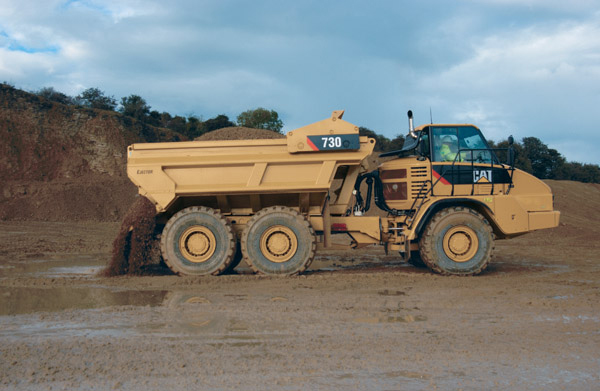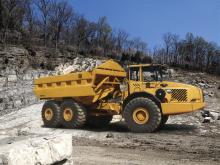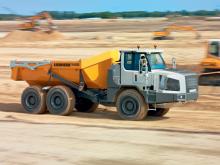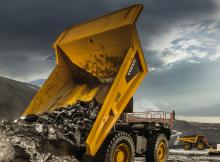
Mike Woof takes a look at the ever-increasing versatility of the articulated dump truck
The articulated dump truck (ADT) has developed over the years as a go-anywhere, heavy-duty haulage machine. The market for ADTs in quarrying has increased progressively over time and this trend is set to continue.
While rigid trucks offer a longer operating life as a rule, they are more expensive to buy and are more restricted as to the types of terrain they can be operated on. With many quarries becoming deeper and haul roads having to become steeper so as to keep operations within set boundaries, ADTs offer a dependable haulage solution that can cope with sharp inclines.
Evolution However as the ADT concept matures, it is also evolving and in a number of different directions. An interesting development noticeable at the recent
Although powered scrapers are highly efficient as earthmoving tools, they can only be used in a comparatively narrow range of applications and are not nearly as versatile as ADTs. Following a reduction in the numbers of new highway construction projects in North America and Europe, the market for self-powered scrapers shrank. Compared with the large number of manufacturers previously offering these machines, only
However, many operations now use agricultural tractors to tow scraper units for earth-stripping duties. This combination is comparatively inexpensive and offers high utilisation, although there are questions over the suitability of agricultural tractors in such applications. Many do not meet standards for operator protection or noise output for industrial duties, as well as not offering the working life contractors require.
Bell first introduced a range of tractors based on its ADTs and worked with towed scraper manufacturers for some markets.
While
Off-loading Caterpillar is another firm to recognise the demand for towed scrapers, buying the E-Ject product range earlier this year. The Caterpillar Elkader range includes high-performance and standard towed scrapers, as well as ejector trailers. The scrapers can be towed behind Caterpillar dozers and can be operated in single or tandem configuration. The company also offers the E-45 ejector trailer, a top-loading trailer unit designed to be used on a Cat 740 articulated dump truck chassis, with its body removed, and replaced with a fifth wheel. This trailer offers a greater payload with its 50tonne capacity and is said to increase the capacity of the 740 ADT by 50% per cycle in long-distance haulage applications, while it dumps using a scraper-type ejector system.
Ejector type ADTs also offer potential benefits for quarrying applications that have yet to be fully realised. These can be used to handle aggregates in difficult working conditions, as long as the bodies are able to cope with high abrasion levels and the market for these niche products is increasing.
UK firm DDT first began offering machines in the mid 1990s, pointing out that the discharge trucks were safer as they were more stable, unlikely to suffer from striking power lines or other overhead obstructions while tipping. The firm was also keen to highlight that its trucks could dump while operating on a slope and could be used to spread a load over an area if required.
The DDT discharge machines suffered some problems however, and the firm continued supplying conventional tipping trucks instead, later being bought out by the
When Caterpillar saw this, the company decided the concept had potential and worked with the contractor and developed a more sophisticated machine, using bowl ejection technology from its motor scraper range. Caterpillar then unveiled its D400 ejection truck, which was later replaced by the present 740-based model and joined by the smaller 730 ejection machine.
Other ADT manufacturers have had ejection trucks in the range too with Terex and more recently Moxy, both offering machines featuring systems specialist truck body Phillippi-Hagenbuch. Moxy's new MDT31 model retains Moxy's sloping rear chassis and single rear differential, with gear drive to all four rear wheels. Like the Caterpillar truck, these use an ejection system featuring hydraulic rams and a pusher plate.
Some ejection systems are particularly well-suited to use with more abrasive materials such as the system Bell unveiled some years ago, which featured heavy duty chains to move the pusher plate. Bell chose instead to concentrate on developing its huge B50 truck and for the moment, its ejector machine is not available.
The on/off highway Multidrive truck even used a rubber belt for its ejection system and, strange as it may sound, this approach was well-suited to haulage duties involving hard and abrasive materials such as rock. The future of the Multidrive truck is at present unclear, although it is entirely possible that the rubber belt ejection approach will resurface in an off-highway hauler at some point. It is worth remembering too that in underground mining, dump trucks with ejector type bodies are widely used to handle very abrasive grades of rock and ore, using heavy-duty components and technology that is extremely robust and would well suit the most arduous of quarrying applications.
Cycle times Cycle times and performance have consistently been targets for ADT designers. The development of an ADT with a sophisticated double wishbone suspension system at the front by Terex for its TA30 has offered other potential. The machine offers a good ride quality even at speed over rough surfaces, reducing spillage from the trucks' body and allowing the machine to reduce cycle times in difficult conditions. This type of suspension also offers a high level of steering precision, allowing the operator to manoeuvre the machine accurately when running at speed.
However, the potential remains for an ADT featuring fully independent suspension at the rear axles, as well as at the front. While the technology required may not be cheap, the performance benefits could offer major advantages by reducing cycle times and allow for a comparatively fast payback period for the customer to recoup the investment necessary.
Meanwhile, alternatives to current drive systems also offer potential. Some years ago Terex fitted a high speed hydrostatic drive to a scraper and testing showed the concept offered some potential for the ADT market. While Terex opted not to continue developing this innovative system, another manufacturer has been working on an ADT featuring hydrostatic drive for some time.
Using a hydrostatic drive in an ADT offers the chance to move away from the complex array of gearboxes, driveshafts and differentials, much of which is mounted in a comparatively vulnerable location underneath an ADT. It is worth remembering that virtually all ADT manufacturers have at one time seen their model types suffering driveline problems. The all-wheel-drive system that gives the ADT its go-anywhere capability can also become its Achilles heel, due to its relative complexity, vulnerability to damage and its need for regular maintenance.
Simple solution? A hydrostatic drive is relatively simple by comparison, with pumps and motors instead of the complex mechanical drive linkages used in a conventional driveline. As has been seen in the wheeled loader market, hydrostatic drives can offer an effective alternative to using driveshafts and differentials. Whether this latest machine being trialled will reach the market in its current form remains to be seen and although the truck has been seen under test regularly, the manufacturer has not so far opted to launch the product.
Clearly, using a hydrostatic drive in an ADT poses interesting engineering challenges to designers. Ensuring the fluid in the drive system has sufficient cooling is a particular challenge. Initial attempts to fit ADTs with fully-enclosed, oil-cooled brakes led to problems with cooling for the rear discs. The trucks had their cooling systems on the front chassis and forward of the articulation hitch. This resulted in large quantities of hot oil having to be shuttled forward past the swivel point, a feature that presented some challenges until solutions could be found. Extra large coolers were fitted on the forward chassis of some trucks, while others feature a comparatively large oil bath area within the rear axles themselves, giving the necessary cooling effect.
For a hydrostatic drive system in an ADT, all the fluid will have to be carried rearward from pumps connected to the engine in the front chassis and past the articulation hitch. Cooling the hot oil is important to ensure performance though, so the designers will have to locate the cooling system carefully so as to prevent it from being damaged in a tough working environment, while also ensuring it works effectively.
Hydrostatic drives would offer good braking capabilities too, although the current generation of fully enclosed disc brakes used in many of the latest ADTs offer far better stopping ability than drums used in early machines and lower maintenance needs than dry discs.
Looking further ahead, the development of an AC drive for Caterpillar's D7E dozer (see Equipment Update) could also have potential for the ADT market. Large rigid haul trucks for the mining sector have diesel/AC drives and this technology would offer another alternative to mechanical drivelines. Whether such drives would be suitable for ADTs is a topic for future debate.








